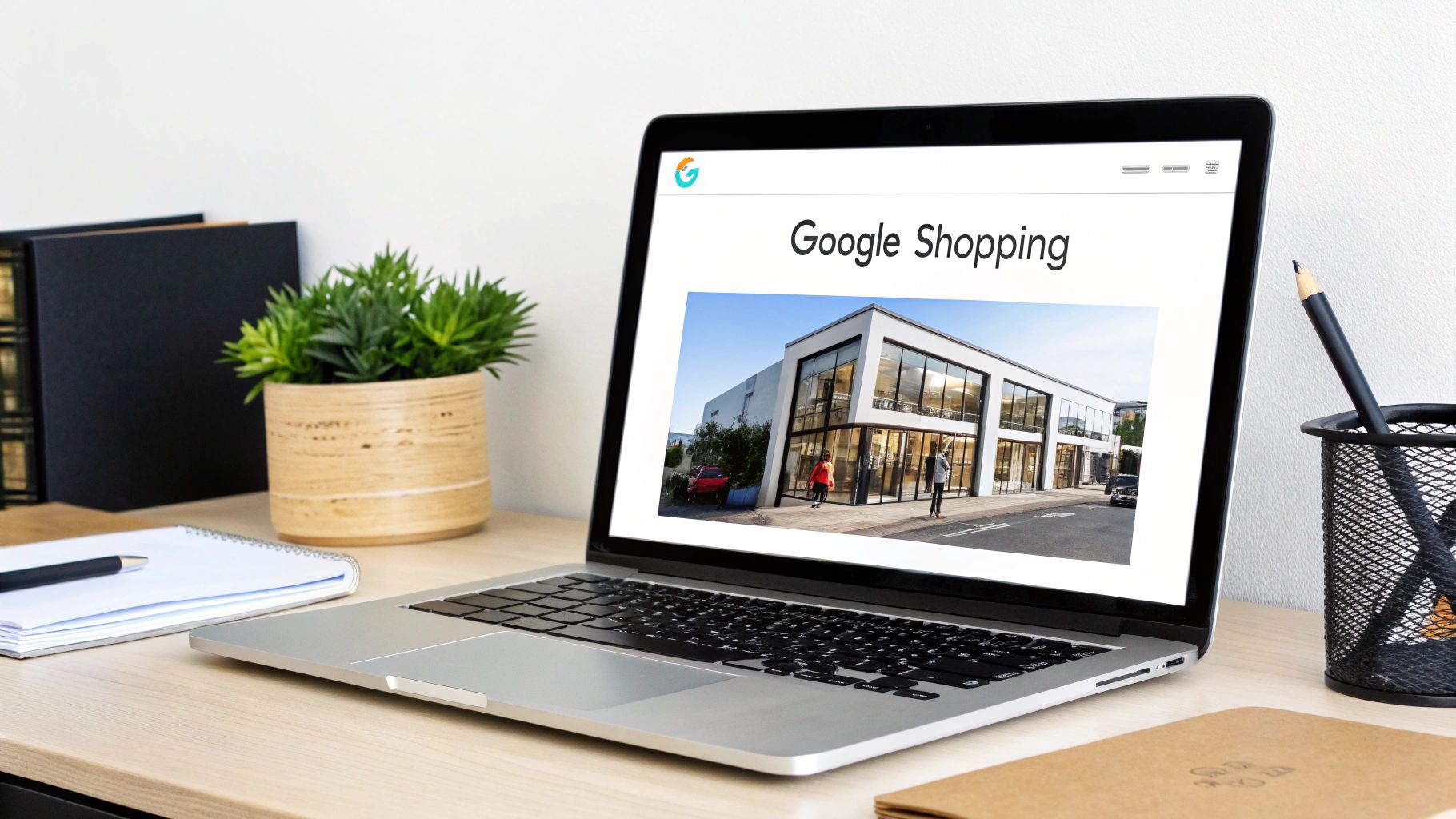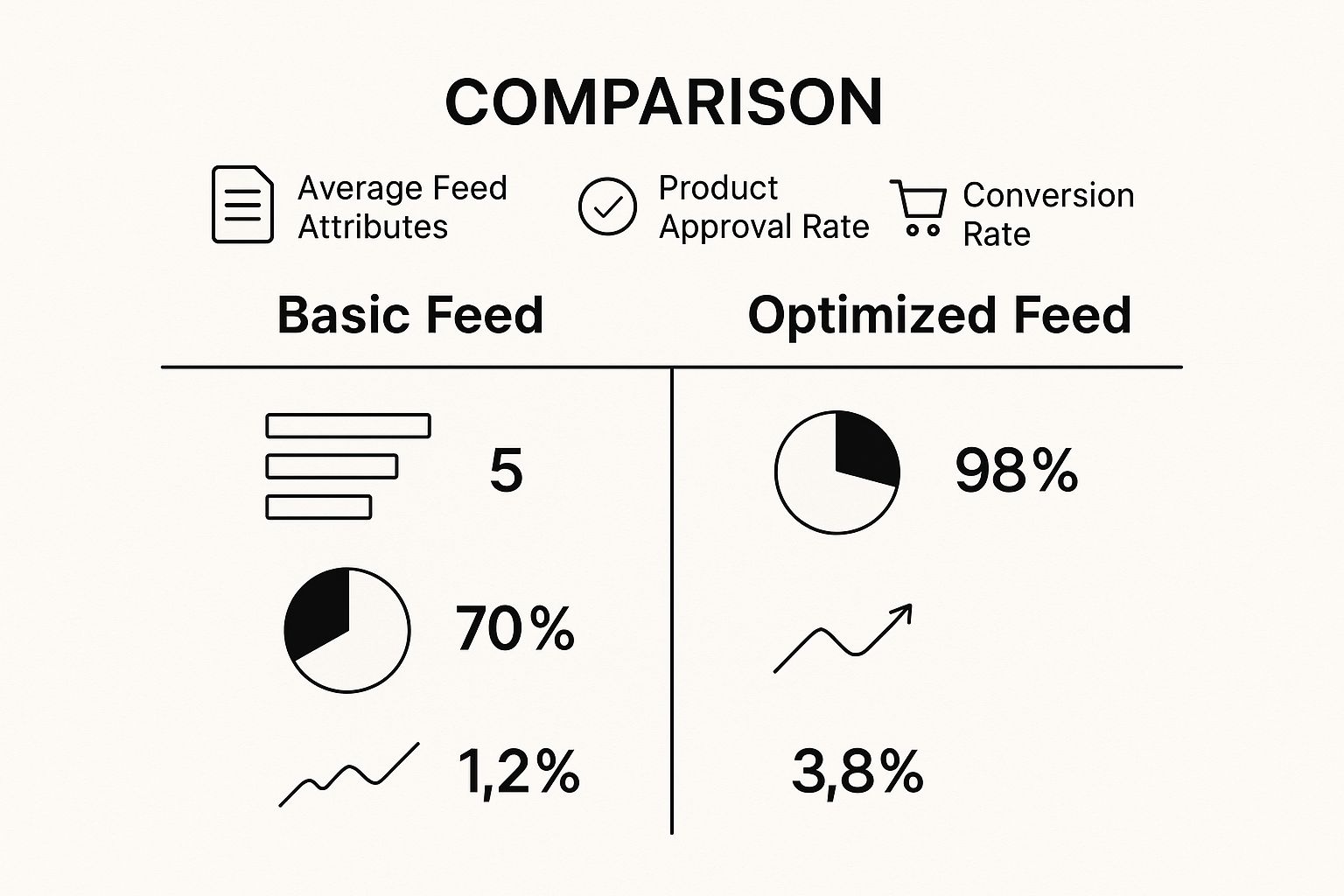How to Advertise Google Shopping | UK Guide to Growth

How to Advertise Google Shopping | UK Guide to Growth: To really make an impact with Google Shopping, UK retailers need to craft visually appealing product listings that pop up right in the search results. This isn’t just about advertising; it’s about catching high-intent buyers at the exact moment they’re ready to pull out their wallets. These ads are miles ahead of plain text, showing off a product image, title, price, and your store name, which is why they often deliver much higher conversion rates.
Why Google Shopping Ads Are a Game Changer for UK Retail

For UK retailers, the online marketplace has never been more crowded. It’s tough to stand out. Having a great product isn’t enough anymore—you need to be visible where it really counts. This is where Google Shopping steps in, acting as a direct line to consumers who are actively searching for exactly what you sell.
Unlike standard text ads that have to rely on clever wording, Shopping ads give a rich, visual sneak peek of your product. This immediate visual hook helps pre-qualify your clicks, so the people landing on your site are genuinely interested in what they’ve seen.
Picture a small UK boutique selling handmade leather bags. With a well-tuned campaign, their products can show up right next to listings from massive department stores. It completely levels the playing field.
Connecting with Purchase-Ready Shoppers
The real magic of Google Shopping is its knack for intercepting customers with serious commercial intent. When someone types in “women’s brown leather tote bag,” they’re not just window shopping—they’re sending a clear signal that they’re looking to buy. Getting your product in front of them at this crucial moment is a massive advantage.
It’s this direct connection to motivated buyers that leads so many businesses to see a fantastic return on their ad spend from these campaigns.
The data backs this up. With over 80% of online product journeys in the UK starting with a Google search, its influence is undeniable. Google handles more than 1.4 billion product-related queries daily in the UK alone. And with mobile e-commerce searches jumping by 21% year-over-year, its dominance in product discovery is only growing.
The real power of Google Shopping is its ability to turn a search query into a direct sales opportunity. It closes the gap between discovery and purchase by showing the product, price, and brand all before the first click.
Building a Foundation for Growth
You don’t need a massive budget to succeed here; a smart strategy is far more important. By focusing on high-quality product data and a strategic campaign structure, even small businesses can achieve incredible results. For a detailed breakdown of how to get your campaigns set up for success, have a look at our guide on Google Shopping ads.
And to make sure your Google Shopping efforts fit into a broader growth strategy, check out these essential digital marketing tips for small businesses that can perfectly complement your ad campaigns.
How to Advertise Google Shopping: Laying the Foundations for Google Shopping Success
Before you can start seeing sales from Google Shopping, you need to get the technical groundwork right. Don’t worry, this isn’t about deep-diving into code. It’s simply about connecting the right accounts and feeding Google the kind-of high-quality information it needs to find your ideal customers. Nail this from the get-go, and you’ll save yourself a world of pain later on.
The whole system really boils down to two key pieces of the puzzle: Google Merchant Center (GMC) and your Google Ads account. The easiest way to think about it is that GMC is your digital stockroom—it holds all the nitty-gritty details about every product you sell. Your Google Ads account is the engine that actually takes that product info and turns it into the ads people see and click on.
For any of this to work, these two platforms need to be talking to each other. Linking them is a simple but absolutely critical first step in building a solid Shopping campaign.
The Role of Google Merchant Center
Google Merchant Center is mission control for all your product data. This is where you’ll upload and manage your product feed, which is basically a giant spreadsheet packed with all the attributes for the items you sell. A classic mistake is treating GMC as a set-it-and-forget-it tool. In reality, it needs regular attention to make sure your data is always accurate and doesn’t fall foul of Google’s ever-changing policies.
Here’s a glimpse of the Google Merchant Center dashboard, which will become your new best friend for managing feeds and spotting issues.

This screen gives you a vital health check on your products, flagging up any disapprovals or warnings that need sorting out. Checking this regularly is the key to keeping your ads live and kicking.
Once your GMC account is up and running, you’ll need to verify and claim your website URL to prove you own it. The final piece is linking it to your Google Ads account. You kick this off from inside the Merchant Center settings under “Linked accounts,” which sends a request over to Google Ads for you to approve. For a more detailed, click-by-click walkthrough, our full guide on how to set up Google Shopping has you covered: https://ppcgeeks.co.uk/ppc/how-to-set-up-google-shopping/
Your Product Feed: The Real Cornerstone (How to Advertise Google Shopping)
Let’s be clear: your product feed is the single most important part of your entire Google Shopping setup. It isn’t just a list of what you sell; it’s a rich collection of data points, or attributes, that Google’s algorithm uses to match your products with what people are actually searching for. The more detailed and accurate your feed, the better Google can do its job.
Imagine you’re a UK-based shoe shop. A lazy product feed might just list something as “Men’s Trainers.” An optimised feed, on the other hand, paints a much clearer picture for Google.
- Title: Men’s Classic Leather Trainers – White & Navy – Size 9
- GTIN (Global Trade Item Number): The unique 12-14 digit barcode number. This is non-negotiable for most new products and helps Google identify your exact item.
- Brand: The name of the manufacturer.
- Colour: White/Navy
- Material: Leather
Think of each attribute in your product feed as a signal you’re sending to Google. Vague signals lead to poor matches and wasted ad spend. Specific, detailed signals help Google find shoppers who are looking for exactly what you’re selling.
Providing these specifics helps Google put your ad in front of someone making a super-specific search like “white leather men’s trainers size 9.” A shopper searching like that knows exactly what they want, and getting your product in front of them is a huge win.
Preparing for a Seamless Launch
Before your ads go live, you need to be sure your e-commerce site is ready to turn that traffic into sales. As you’re getting this foundation in place, a crucial part of your setup is sorting out your payment systems. For a helping hand on that front, it’s worth exploring resources on finding the best payment gateway for your business.
There are a few core attributes in your feed that you absolutely have to get right from day one:
- Product ID: A unique code for each item you stock.
- Title: A descriptive, keyword-rich title (up to 150 characters).
- Description: A detailed summary of the product’s features (up to 5,000 characters).
- Link: The direct URL to the product’s page on your website.
- Image Link: The URL for your main, high-quality product photo.
- Price: The product’s price, making sure to include VAT.
- Availability: Is the product ‘in stock’, ‘out of stock’, or available for ‘preorder’?
Getting these fundamentals organised is what separates a campaign that limps along from one that’s primed for success. By putting the time into creating a clean, detailed product feed and linking your accounts properly, you build the strong base needed to truly succeed with Google Shopping.
Right, with all the technical groundwork sorted, it’s time for the fun part: launching your first proper Shopping campaign. This is where you move from the setup phase into active management, making the critical choices in Google Ads that will ultimately decide whether your campaign sinks or swims.
First up, we need to tackle the big decision: do you go with a Standard Shopping campaign or jump straight into Performance Max?
This isn’t just a technical choice; it’s a strategic one, especially here in the UK. The UK ecommerce market is huge and fiercely competitive. We’re talking nearly 60 million shoppers online in 2023, making it the third-largest market on the planet. If you want to grab your slice of that pie, getting your campaign structure right from day one is non-negotiable. You can dive deeper into the numbers on the UK’s ecommerce growth on eMarketer.
Choosing Your Campaign Type: Standard vs. PMax (How to Advertise Google Shopping)
Your first major decision point inside Google Ads is the campaign type. For retailers, Google essentially gives you two main paths: the classic Standard Shopping campaign or the newer, AI-driven Performance Max (PMax). Each has its own strengths, and the best one for you really depends on your goals and how hands-on you want to be.
- Standard Shopping Campaigns offer you maximum control. Think of this as the manual transmission of Google Shopping. You get to set specific bids for different product groups, build out extensive negative keyword lists to weed out irrelevant searches, and have a tight grip on your budget allocation.
- Performance Max (PMax) Campaigns are Google’s automated, all-in-one powerhouse. This is the automatic transmission. PMax uses AI to manage bidding and targeting across Google’s entire advertising ecosystem—Search, Display, YouTube, Gmail, the lot. You feed it the creative assets (text, images, logos, videos), and its algorithms take care of the rest.
Deciding between Standard Shopping and Performance Max is a common dilemma for UK advertisers. Here’s a quick breakdown to help you figure out which is the better fit for your business right now.
Standard Shopping vs Performance Max Campaigns
| Feature | Standard Shopping | Performance Max (PMax) | Best For |
|---|---|---|---|
| Control | High. Granular control over bids, negatives, and targeting. | Low. AI-driven automation with limited manual overrides. | Advertisers who need precise control and have experience. |
| Reach | Google Search & Shopping Tab, Search Partners. | All Google channels: Search, Shopping, YouTube, Display, etc. | Businesses looking for the widest possible reach. |
| Management | More time-intensive. Requires active bid management. | Less time-intensive. Relies on Google’s automation. | Teams with limited time or those new to Google Ads. |
| Data Insights | Detailed reporting on search terms and product performance. | Limited insights. Often feels like a “black box.” | Data-driven marketers who want to analyse search queries. |
| Setup Speed | Slower. Requires careful structuring of campaigns & ad groups. | Faster. Asset-based setup is quicker to get live. | Retailers wanting to launch quickly and gather broad data. |
Pro Tip: If you’re just starting out or short on time, PMax is a fantastic way to get going. It casts a wide net and lets Google’s machine learning find customers. But if you’re a seasoned pro who lives and breathes data and wants to control every penny, sticking with a Standard Shopping campaign will give you the precision you need.
Let’s imagine a small, independent electronics shop in Manchester. They could kick things off with a PMax campaign to get a feel for the market and gather conversion data across all channels. A few months down the line, they might notice their “Sony” headphones are their most profitable line. At that point, they could launch a separate Standard Shopping campaign just for Sony products, giving them granular control to bid more aggressively and really dominate that specific niche.
Setting a Smart Budget and Bidding Strategy (How to Advertise Google Shopping)
Once you’ve picked your campaign type, it’s time to talk money. Your budget shouldn’t be a number plucked from thin air; it needs to be a calculated decision that aligns with your business objectives.
A sensible starting point is to work out a daily budget. Figure out your average cost-per-click (CPC) in your industry and decide how many clicks you realistically want to generate each day. For example, if your average CPC is around £0.50 and you’re aiming for at least 40 clicks to get meaningful data, you’d set a starting budget of £20 per day.
Next, you need to choose a bidding strategy. This tells Google how to spend that budget to hit your goals. While there are several options, these two are the most common and effective for Shopping campaigns:
- Maximise Clicks: Just like it sounds, this strategy aims to get you the most clicks possible for your daily budget. It’s a great choice for a brand new campaign where your main goal is to drive traffic, learn what works, and gather that all-important initial performance data.
- Target ROAS (Return On Ad Spend): This is where things get serious. It’s a value-based strategy where you set a specific return you want for every pound you spend. For instance, setting a Target ROAS of 500% tells Google you want to generate £5 in revenue for every £1 of ad spend. This is powerful, but it absolutely requires rock-solid conversion tracking to work.
Choosing the right bidding strategy is the difference between just getting traffic and actually driving profitable growth.
The image below really drives home how a well-optimised product feed—the foundation of any good Shopping campaign—directly influences your most important metrics.

As you can see, going from a basic feed to one that’s rich with detail does more than just get your products approved; it can more than double your conversion rate. That’s the power of good data.
Structuring Your Campaign for Control and Clarity
A messy, disorganised campaign is a fast track to wasted money and headaches. A logical structure is everything. It allows you to manage your campaigns effectively, analyse performance clearly, and make smart optimisations.
One of the most reliable ways to structure your account is to segment campaigns by categories that actually mean something to your business.
Let’s go back to our electronics store. They stock Sony, Samsung, and Bose products, covering categories like TVs, headphones, and speakers.
A poor structure would be to just dump every single product into one campaign and one ad group. You’d have zero control and no idea what’s actually working.
A much, much better approach is to create separate campaigns for each of your key brands.
- Campaign 1: Sony Products
- Campaign 2: Samsung Products
- Campaign 3: Bose Products
From there, you can break it down further with ad groups based on the product type within each brand campaign. So, inside the “Sony Products” campaign, you might have:
- Ad Group 1: Sony TVs
- Ad Group 2: Sony Headphones
- Ad Group 3: Sony Soundbars
This tiered structure is incredibly powerful. It means you can allocate different budgets to each brand depending on profit margins or stock levels. You can also set different bids at the ad group level—maybe you want to bid higher on “Sony TVs” during the World Cup, for example. This level of organisation turns a chaotic mess of products into a finely tuned machine built for performance.
How to Advertise Google Shopping: Turning Your Product Feed Into a Sales Engine

Let’s be blunt: your product feed is the engine for your entire Google Shopping strategy. A weak, neglected feed is a guarantee that your campaigns will sputter and fail before they even get going. This section is all about transforming that basic spreadsheet into a high-performance machine that drives sales.
It all boils down to giving Google the richest, most accurate data you possibly can. When you feed the algorithm well, it works its magic, matching your products with pinpoint accuracy to shoppers who are ready to buy. This isn’t just a box-ticking exercise; it’s a strategic move that has a direct impact on your bottom line.
Crafting Product Titles That Actually Convert
Your product title is, without a doubt, the most critical part of your entire feed. It’s often the very first thing a potential customer reads before they decide whether or not to click. A lazy title like “Men’s Jumper” is a massive wasted opportunity.
A strong title needs to be descriptive, packed with the right keywords, and structured logically. You have to get inside your customer’s head. What search terms are they actually typing into Google?
A proven formula that works across many product categories is: Brand + Product Type + Key Attributes (Colour, Size, Material).
For example, a title like “Barbour Men’s Quilted Gilet – Olive Green – Size Large” is infinitely more powerful than just “Barbour Gilet.” It instantly answers multiple search queries, attracting a much more qualified, high-intent click.
Why High-Quality Images Are Non-Negotiable (How to Advertise Google Shopping)
In the thumb-scrolling world of Google Shopping, your product image has a split second to grab a user’s attention. Poor-quality, blurry, or cluttered images will be scrolled past every single time. Your main image needs to be a crystal-clear shot of the product, ideally on a clean, white background.
Your product image isn’t just a thumbnail; it’s your digital shop window. It has to be enticing enough to make someone stop, look closer, and step inside your online store.
But don’t just stop at one photo. Use the additional_image_link attribute to your advantage. Show your product from different angles, in a lifestyle setting, or with close-ups that highlight key features. If you sell clothing, this could mean showing a jumper on a model, a zoomed-in shot of the fabric, and a flat-lay view. These extra images provide crucial context and can give your conversion rates a serious lift.
The Strategic Power of Custom Labels
Now, this is where you can start getting really clever with your campaigns. Custom labels (custom_label_0 through custom_label_4) are essentially blank fields in your feed that you can use to slice and dice your product catalogue in any way that makes sense for your business. Google’s algorithm doesn’t read them, but you can use them within Google Ads to build highly specific product groups for bidding.
The possibilities here are incredibly powerful for anyone wanting to advertise on Google Shopping with more precision.
- By Price Point: Label items as ‘budget’, ‘mid-range’, or ‘premium’.
- By Profit Margin: Tag products as ‘high-margin’ or ‘low-margin’ so you can bid more aggressively on your most profitable items.
- By Seasonality: A fashion retailer could use a ‘winter-essentials’ label to easily group and push specific products from October onwards.
- By Performance: Flag your ‘bestsellers’ or ‘poor-sellers’ to inform your bidding strategy.
Using custom labels effectively moves you from being a reactive advertiser to a proactive one. It lets you build campaigns around your real business goals, not just your product categories.
Using Supplemental Feeds to Add and Override Data (How to Advertise Google Shopping)
So, what happens if you want to add a custom label for a flash sale but you don’t want to mess with the master product feed coming from your e-commerce platform? The answer is a supplemental feed.
Think of a supplemental feed as a smaller, secondary data source that you can use to add or even override attributes in your main feed. It links up to your primary feed using the product id attribute.
For instance, you could create a simple spreadsheet with just two columns: id and custom_label_0. You’d then list the product IDs you want to include in your “Summer Sale” and give them the appropriate label. Upload this as a supplemental feed in Merchant Center, and it will apply that label without you ever touching your core product data. This keeps your main feed clean while giving you huge flexibility.
For a deeper dive into mastering these techniques, our comprehensive guide to optimising your Google Shopping product feed is a fantastic resource.
How to Advertise Google Shopping: Smart Moves to Scale Your Ad Performance
Once your campaigns are up and running, the real work begins. Getting from a functional setup to a high-performing, scalable advertising machine means shifting your focus from launching to optimising. This is where you bring in the advanced strategies that separate average results from the truly excellent ones.
It’s all about making smart, data-driven decisions that plug leaks in your budget and double down on what’s working. The goal is to continuously refine your approach, making sure every pound spent works harder to grow your business.
Stop Wasting Money with Negative Keywords (How to Advertise Google Shopping)
One of the quickest ways to boost your campaign’s profitability is by telling Google what not to show your ads for. This is the art of using negative keywords. They stop your ads from showing up for irrelevant searches that might sound similar but have completely different intent.
Think about a home goods store that only sells new furniture. Their budget would evaporate on clicks from people searching for “used dining table” or “second-hand sofa.”
By adding broad match negative keywords like -used and -second-hand to their campaign, they immediately cut off this irrelevant audience. It’s a simple move that redirects their ad spend towards shoppers who are actually looking to buy new, significantly improving their return on investment.
A well-maintained negative keyword list acts as a filter for your ad spend. It doesn’t just save you money on wasted clicks; it actively improves the quality of your traffic and the accuracy of your campaign data.
Make it a habit to check your Search Terms Report in Google Ads. This report shows you the exact queries that triggered your ads. Comb through it weekly to spot and block any irrelevant terms that are costing you money.
Re-Engage Lost Customers with Remarketing (How to Advertise Google Shopping)
Did you know that around 70% of online shopping carts are abandoned? That’s a huge number of potential customers who showed strong interest but didn’t quite make it over the finish line. This is where remarketing comes in as a powerful tool to bring them back.
Remarketing lets you show targeted ads specifically to people who have already visited your website. You can get incredibly specific with your audiences, too.
- All Visitors: A general audience to keep your brand top of mind.
- Product Viewers: People who looked at specific products but didn’t add them to their basket.
- Cart Abandoners: The highest-intent audience; they were just one step away from buying.
Our home goods store, for instance, could create a dynamic remarketing campaign showing cart abandoners the exact products they left behind. Pair that with a compelling offer like “10% off to complete your order,” and you’ve got an incredibly effective tactic for recovering lost sales.
Analyse Data to Fuel Your Growth
To really succeed with Google Shopping, you have to get comfortable with performance data. Your campaign reports are a goldmine of insights, telling you exactly what’s working and what isn’t. Don’t let the numbers intimidate you; just focus on a few key metrics to guide your decisions.
Start by segmenting your products to identify your winners and losers. Look at metrics like:
- Return on Ad Spend (ROAS): The ultimate measure of profitability.
- Conversion Rate: The percentage of clicks that result in a sale.
- Click-Through Rate (CTR): How engaging and relevant your product listings are.
- Cost per Conversion: How much you’re paying for each sale.
Let’s go back to our home goods store. After a month, they dig into their data and find that while their “Oak Dining Tables” have a fantastic ROAS of 800%, their “Decorative Vases” are only just breaking even with a 150% ROAS. That’s a clear signal.
This insight allows them to reallocate their budget strategically. They can pull back on the bids for the underperforming vases and pump more budget into their highly profitable dining tables. This single, data-guided move can significantly lift the entire campaign’s performance without increasing the overall spend. This is a core principle for maximising your ROI with Google Pay Per Click advertising.
The power of these strategies is amplified by current UK consumer behaviour. With over 85% of UK consumers making an online purchase in the last month and 70% using smartphones as their main shopping tool, a mobile-first, data-driven approach is essential. To understand more about these trends, you can explore UK ecommerce statistics from Hostinger. By continuously analysing, refining, and scaling, you turn your Google Shopping campaigns into a reliable engine for business growth.
Got Questions About Google Shopping? We’ve Got Answers (How to Advertise Google Shopping)
When you’re just getting your feet wet with Google Shopping, it’s natural for a few questions to bubble up. Honestly, it happens to everyone. So, let’s run through some of the most common queries we hear from UK businesses, clear the air, and get you moving forward.
One of the first headaches is often seeing your products disapproved in the Google Merchant Center. If you log in to see a sea of red, don’t panic. The usual suspects are pretty straightforward: prices in your feed that don’t match your website, blurry or low-quality images, or missing GTINs (that’s the barcode number). Your first port of call should always be the ‘Diagnostics’ tab in GMC – it tells you exactly what’s wrong.
Then there’s the age-old question: “How much should I actually spend?” There’s no single magic number, but a solid rule of thumb is to set a budget that can get you at least 10-20 clicks a day. This gives the algorithm enough data to start learning without you having to remortgage the house. For a brand-new campaign, kicking off with £15-£25 daily is a sensible starting point. You can always tweak it once you see how things are going.
Why Can’t I See My Ads? (How to Advertise Google Shopping)
This one is incredibly frustrating, but trust us, it’s a common bump in the road. If your ads are playing hide-and-seek, it’s usually down to one of a few things:
- Your bids are too low: You might simply be getting outbid in the auction. A little bump can sometimes be all it takes to get things moving.
- Your targeting is too narrow: Being too restrictive with your location or audience settings can choke your campaign before it even starts.
- The account is under review: It’s standard for new accounts or campaigns to go through a short review period. Give it a little time.
Our Pro Tip: Patience is your best friend here. A new campaign can often take a few days to get up to full speed and start showing consistently. Try to resist the urge to make any big, knee-jerk changes in the first 72 hours.
Finally, a lot of advertisers get concerned when their ROAS (Return On Ad Spend) is low right out of the gate. This is completely normal. Campaigns need time to collect conversion data, which Google’s AI uses to get smarter and find more people who are ready to buy. Your initial focus should be on polishing your product feed and building out your negative keywords. Do that, and the profit will follow.
Ready to stop the guesswork and start building a genuinely profitable Google Shopping machine? The team at PPC Geeks lives and breathes this stuff. We build and scale winning strategies so you can get back to running your business. Find out how we can help your brand grow.
Author
Search Blog
Free PPC Audit
Subscribe to our Newsletter
The Voices of Our Success: Your Words, Our Pride
Don't just take our word for it. With over 100+ five-star reviews, we let our work-and our satisfied clients-speak for us.
"We have been working with PPC Geeks for around 6 months and have found Mark and the team to be very impressive. Having worked with a few companies in this and similar sectors, I rate PPC Geeks as the strongest I have come across. They have taken time to understand our business, our market and competitors and supported us to devise a strategy to generate business. I value the expertise Mark and his team provide and trust them to make the best recommendations for the long-term."
~ Just Go, Alasdair Anderson
